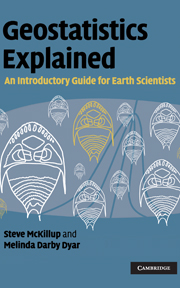Book contents
- Frontmatter
- Contents
- Preface
- 1 Introduction
- 2 “Doing science”: hypotheses, experiments and disproof
- 3 Collecting and displaying data
- 4 Introductory concepts of experimental design
- 5 Doing science responsibly and ethically
- 6 Probability helps you make a decision about your results
- 7 Working from samples: data, populations and statistics
- 8 Normal distributions: tests for comparing the means of one and two samples
- 9 Type 1 and Type 2 error, power and sample size
- 10 Single-factor analysis of variance
- 11 Multiple comparisons after ANOVA
- 12 Two-factor analysis of variance
- 13 Important assumptions of analysis of variance, transformations and a test for equality of variances
- 14 Two-factor analysis of variance without replication, and nested analysis of variance
- 15 Relationships between variables: linear correlation and linear regression
- 16 Linear regression
- 17 Non-parametric statistics
- 18 Non-parametric tests for nominal scale data
- 19 Non-parametric tests for ratio, interval or ordinal scale data
- 20 Introductory concepts of multivariate analysis
- 21 Introductory concepts of sequence analysis
- 22 Introductory concepts of spatial analysis
- 23 Choosing a test
- Appendices
- References
- Index
17 - Non-parametric statistics
Published online by Cambridge University Press: 05 June 2012
- Frontmatter
- Contents
- Preface
- 1 Introduction
- 2 “Doing science”: hypotheses, experiments and disproof
- 3 Collecting and displaying data
- 4 Introductory concepts of experimental design
- 5 Doing science responsibly and ethically
- 6 Probability helps you make a decision about your results
- 7 Working from samples: data, populations and statistics
- 8 Normal distributions: tests for comparing the means of one and two samples
- 9 Type 1 and Type 2 error, power and sample size
- 10 Single-factor analysis of variance
- 11 Multiple comparisons after ANOVA
- 12 Two-factor analysis of variance
- 13 Important assumptions of analysis of variance, transformations and a test for equality of variances
- 14 Two-factor analysis of variance without replication, and nested analysis of variance
- 15 Relationships between variables: linear correlation and linear regression
- 16 Linear regression
- 17 Non-parametric statistics
- 18 Non-parametric tests for nominal scale data
- 19 Non-parametric tests for ratio, interval or ordinal scale data
- 20 Introductory concepts of multivariate analysis
- 21 Introductory concepts of sequence analysis
- 22 Introductory concepts of spatial analysis
- 23 Choosing a test
- Appendices
- References
- Index
Summary
Introduction
Parametric tests are designed for analyzing data from normally distributed populations. Although these tests are quite robust to departures from normality, and major ones can often be reduced by transformation, there are some cases where the population is so grossly non-normal that parametric testing is unwise. In these cases a powerful analysis can often still be done by using a non-parametric test.
Non-parametric tests are not just alternatives to the parametric procedures for analyzing ratio, interval and ordinal data described in Chapters 8 to 16. Often geoscientists obtain data that have been measured on a nominal scale. For example, Table 3.2 gave data for the locations of 594 tornadoes during the period from 1998–2007 in the southeastern states of the US. This is a sample containing frequencies in several discrete and mutually exclusive categories and there are non-parametric tests for analyzing these types of data (Chapter 18).
The danger of assuming normality when a population is grossly non-normal
Parametric tests have been specifically designed for analyzing data from populations with distributions shaped like a bell that is symmetrical about the mean with 66.26% of values occurring within μ ± 1 standard deviation and 95% within μ ± 1.96 standard deviations (Chapter 7). This distribution is used to determine the range within which 95% of the values of the sample mean, will occur when samples of a particular size are taken from a population.
- Type
- Chapter
- Information
- Geostatistics ExplainedAn Introductory Guide for Earth Scientists, pp. 227 - 229Publisher: Cambridge University PressPrint publication year: 2010

